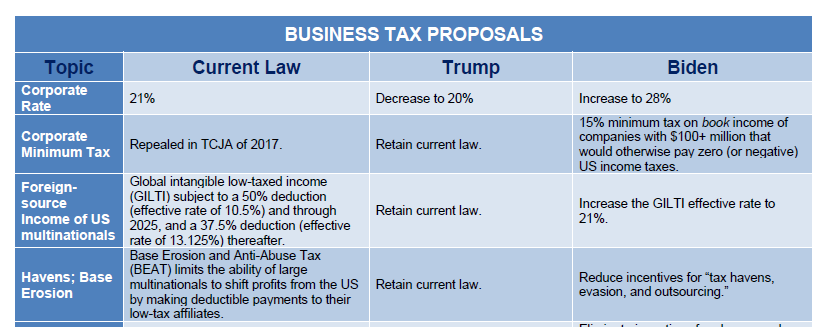2020 Presidential Candidates' Tax Proposals
Election Day is just over a month away. Will there be a “blue wave”? Will Republicans maintain control of the Presidency and the Senate? Who knows? But, at a high level, we can compare what tax policies may be implemented in 2021 (or shortly thereafter) based on the 2020 election results.
President Trump’s tax policies largely came to fruition with passage and implementation of the Tax Cuts and Jobs Act (“TCJA”) in December of 2017. Aside from some minor tweaks and continuing to push for certain measures that did not make it into the TCJA, President Trump’s tax proposals for his second term are minimal. On the other side, Joe Biden’s tax agenda is still developing and an official tax plan with technical details has not been released. However, the Biden campaign recently released a document comparing Biden’s tax proposals to President Trump’s proposals and policies. Biden’s campaign website includes additional policy proposals on a variety of topics, like domestic manufacturing, clean energy, infrastructure, housing, health care, etc., many of which contain tax measures or components.
The following chart highlights the current significant tax proposals of the 2020 Presidential Candidates, Republican nominee President Donald J. Trump and Democratic nominee Joseph R. Biden as of September 22, 2020.
Takeaways
Trump’s tax proposals largely consist of making most of the expiring provisions in the TCJA permanent, reducing the corporate and capital gains rates, creating a carrot-and-stick approach for domestic companies to bring back jobs previously sent offshore, and repealing incentives for clean energy.
Biden’s tax proposals are brief, high level, and described in laymen’s terms for the general electorate. Still, Biden’s proposals reveal a desire to increase the corporate tax rate, impose higher rates and limit itemized deductions on taxpayers making over $400,000, restore and expand clean energy incentives, create a carrot-and-stick approach for domestic companies to bring back jobs previously sent offshore, increase incentives to promote domestic manufacturing, and reduce the estate tax base exclusion amount.
If there is a divided government consisting of Trump serving his second term as President, a Republican Senate, and a Democratic House, then the current status quo likely will not change, which means that not many of Trump’s limited tax proposals will be implemented, except for possibly the carrot-and-stick approach for domestic companies to bring back jobs previously sent offshore and any domestic manufacturing incentives.
If there is a divided government consisting of Biden serving his first term as President, a Republican Senate, and a Democratic House, it is hard to image many of Biden’s tax proposals being enacted, or even coming to a vote in the Senate.
If there is a divided government consisting of Trump serving his second term as President, a Democratic Senate, and a Democratic House, it will be fascinating to see which of Biden’s proposals a Democratic Congress adopts and passes, how many of those bills Trump vetoes, and how many actually end-up enacted into law.
If there is a “blue wave” resulting in a unified government of Biden serving his first term as President, a Democratic Senate, and a Democratic House, the passage of many of Biden’s tax proposals may be imminent, but it will be interesting to see how and which proposals are prioritized and which ones are put on hold until after mid-term elections or a potential second term. Some factors driving this prioritization may include: (1) the size of the “blue wave,” i.e., what kind of majority do the Democrats actually hold; (2) the state of the economy given the pandemic; (3) personnel – who Biden chooses to staff and run his administration; (4) the impact of the anticipated political blow-back from increasing taxes; and (5) how the Republican party acts post-Trump and in a minority position.
Time will time tell. Some or none of these tax proposals may be implemented depending on the results of the 2020 election. Keep checking for updates and additional Insights here. For more detailed information and guidance please reach-out to David M. McCallum and your Nexsen Pruet Tax Team.
Election Day is just over a month away. Will there be a “blue wave”? Will Republicans maintain control of the Presidency and the Senate? Who knows? But, at a high level, we can compare what tax policies may be implemented in 2021 (or shortly thereafter) based on the 2020 election results.
President Trump’s tax policies largely came to fruition with passage and implementation of the Tax Cuts and Jobs Act (TCJA) in December of 2017. Aside from some minor tweaks and continuing to push for certain measures that did not make it into the TCJA, President Trump’s tax proposals for his second term are minimal. On the other side, Joe Biden’s tax agenda is still developing and an official tax plan with technical details has not been released. However, the Biden campaign recently released a document comparing Biden’s tax proposals to President Trump’s proposals and policies. Biden’s campaign website includes additional policy proposals on a variety of topics, like domestic manufacturing, clean energy, infrastructure, housing, health care, etc., many of which contain tax measures or components.
The following chart highlights the current significant tax proposals of the 2020 Presidential Candidates, Republican nominee President Donald J. Trump and Democratic nominee Joseph R. Biden as of September 22, 2020.
See the full Tax Table here.
Takeaways
Trump’s tax proposals largely consist of making most of the expiring provisions in the TCJA permanent, reducing the corporate and capital gains rates, creating a carrot-and-stick approach for domestic companies to bring back jobs previously sent offshore, and repealing incentives for clean energy.
Biden’s tax proposals are brief, high level, and described in laymen’s terms for the general electorate. Still, Biden’s proposals reveal a desire to increase the corporate tax rate, impose higher rates and limit itemized deductions on taxpayers making over $400,000, restore and expand clean energy incentives, create a carrot-and-stick approach for domestic companies to bring back jobs previously sent offshore, increase incentives to promote domestic manufacturing, and reduce the estate tax base exclusion amount.
If there is a divided government consisting of Trump serving his second term as President, a Republican Senate, and a Democratic House, then the current status quo likely will not change, which means that not many of Trump’s limited tax proposals will be implemented, except for possibly the carrot-and-stick approach for domestic companies to bring back jobs previously sent offshore and any domestic manufacturing incentives.
If there is a divided government consisting of Biden serving his first term as President, a Republican Senate, and a Democratic House, it is hard to image many of Biden’s tax proposals being enacted, or even coming to a vote in the Senate.
If there is a divided government consisting of Trump serving his second term as President, a Democratic Senate, and a Democratic House, it will be fascinating to see which of Biden’s proposals a Democratic Congress adopts and passes, how many of those bills Trump vetoes, and how many actually end-up enacted into law.
If there is a “blue wave” resulting in a unified government of Biden serving his first term as President, a Democratic Senate, and a Democratic House, the passage of many of Biden’s tax proposals may be imminent, but it will be interesting to see how and which proposals are prioritized and which ones are put on hold until after mid-term elections or a potential second term. Some factors driving this prioritization may include: (1) the size of the “blue wave,” i.e., what kind of majority do the Democrats actually hold; (2) the state of the economy given the pandemic; (3) personnel – who Biden chooses to staff and run his administration; (4) the impact of the anticipated political blow-back from increasing taxes; and (5) how the Republican party acts post-Trump and in a minority position.
Time will tell. Some or none of these tax proposals may be implemented depending on the results of the 2020 election. Keep checking for updates and additional Insights here. For more detailed information and guidance please reach-out to David M. McCallum and your Nexsen Pruet Tax Team.
About Maynard Nexsen
Maynard Nexsen is a full-service law firm with more than 550 attorneys in 24 offices from coast to coast across the United States. Maynard Nexsen formed in 2023 when two successful, client-centered firms combined to form a powerful national team. Maynard Nexsen’s list of clients spans a wide range of industry sectors and includes both public and private companies.








